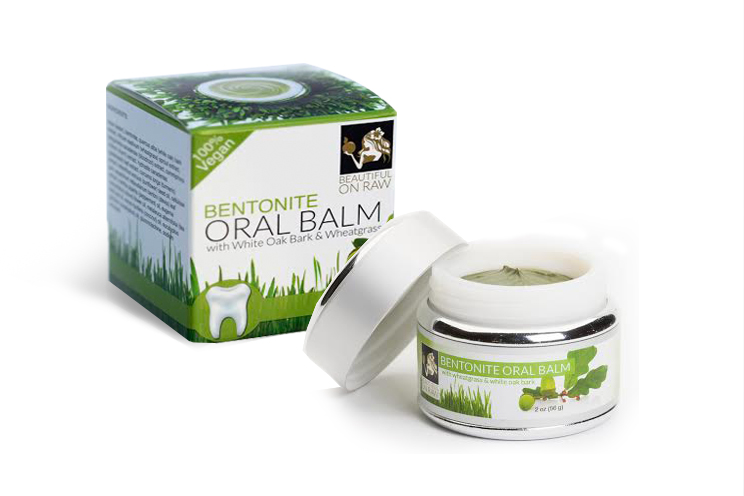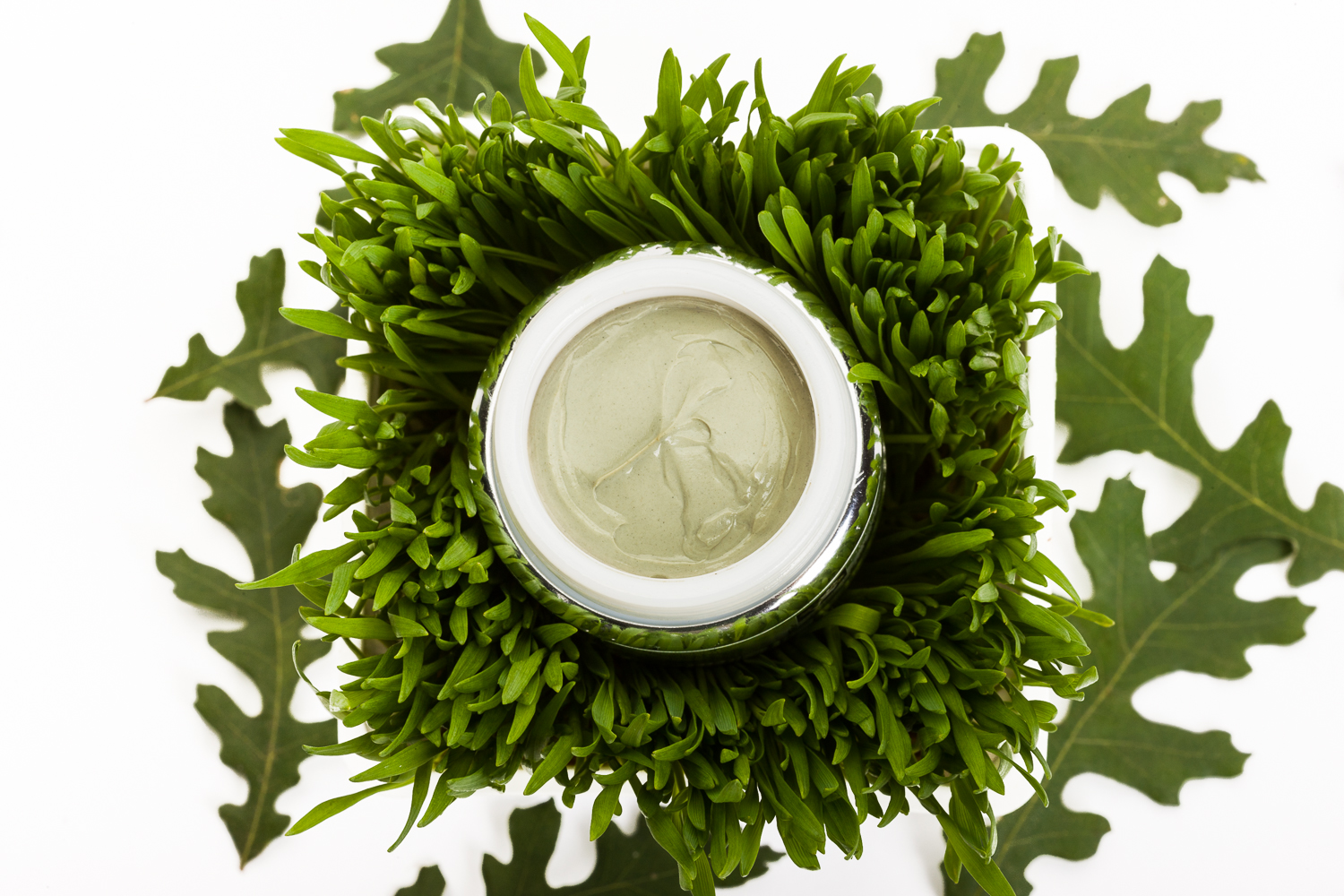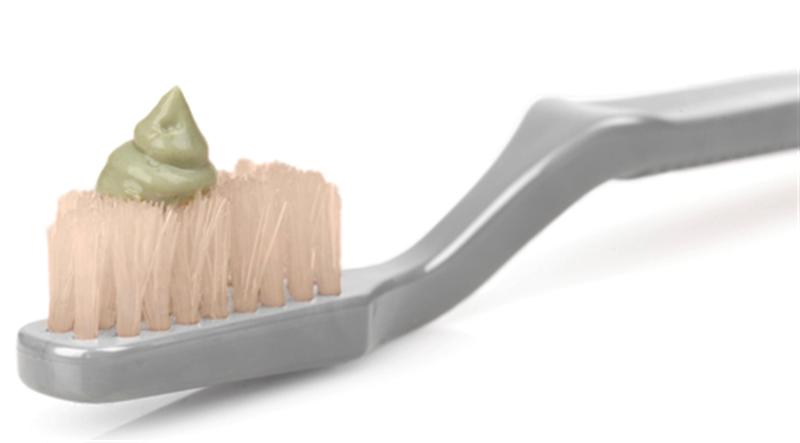Bentonite Oral Balm

with White Oak Bark and Wheatgrass
Bentonite clay with white oak bark and wheatgrass extract along with these other beneficial herbs is an unbeatable combination to leave your mouth fresh, clean and healthy. The difference is so remarkable, I wouldn’t be surprised if you’d never want to use a regular white (silica) toothpaste again.
Taking extra care of your teeth now can save you thousands of dollars in the future by letting you avoid expensive and agonizing dental procedures like root canals, crowns and implants. Learn more about Gum Disease...What Can You Do? here.
What's Wrong with Conventional Toothpaste?
One of the most important things you can do for your overall dental health is to stop using toothpaste off drugstore and supermarket shelves, even if they are cheaper. Commercials and popular culture condition us to associate its refreshing flavor and sudsy action with cleanliness and oral hygiene. But the truth is: Conventional toothpaste just doesn't belong in a healthy person's toiletry kit.
Why wouldn't I consider using it again? Regular store-bought toothpastes contain a soup of damaging chemicals. Want proof? Start by reading the warning label on the back of your toothpaste tube. Swallowing toothpaste, especially fluoridated brands, can lead to diarrhea and nausea. Toothpaste must be kept away from children under six, and if you ingest an amount greater than needed for brushing, it's time to call either a physician or the Poison Control Center.

Question: If you can't eat it, does it have any business being in your mouth?
Toothpaste is a symphony of artificial ingredients, some of which are known to be unhealthful - hence the warning labels. Chemical stabilizers, preservatives, foaming agents, dyes, and artificial flavorings - you'll find all of these in common toothpastes, occasionally accompanied by bleaching agents. Molecules of these ingredients may penetrate the sensitive, porous mucous membranes and tissues of the mouth, enter the bloodstream and build up in other tissues and organs. Insidiously, they contribute to a toxic overload and can, in the long run, do your teeth more harm than good.
Most commercial toothpastes, and sadly even some ‘natural’ ones found in health food stores, contain ingredients you'd be smart to avoid. What's more, as you'll find when you're farther along in your raw foods journey, commercial toothpastes taste horrendous to a healthy mouth.
I have purchased your Bentonite Oral Balm, and I have to say it has changed my mouth health from using just one jar, My dentist was very impressed to say the least.
I am re- purchasing the product, and I would love your permission to do a small review on my Instagram, as this product truly changed my Gum health and I want to share with my friends and followers. I believe oral hygiene is often overlooked, and this product needs to be aknowleged.
Concluding my message, I would like to thank you for giving my mouth the opportunity to be it’s healthiest, and I would love to try more of your products as I am very interested in Your Organic products.
Fluoride.
The best-known ingredient in commercial toothpastes is fluoride. The facts about fluoride's side effects and health hazards are no longer secret. Fluoride has in times past been aggressively promoted as mandatory for preventing cavities. Recently, however, the pendulum has begun to swing in the opposite direction, and we're learning that fluoride is not the panacea it was originally touted to be. Fluoride is associated with thyroid dysfunction, for example, because it acts as a hormone disruptor. Fluoride can sever the protein molecules that help gums adhere to teeth, contributing to gum pockets. Excess fluoride (called dental fluorosis) can lead to the pitting and discoloration of tooth enamel.
Silica.
Is derived from silicon dioxide, a mineral found abundantly all over the Earth. Translation: sand - a highly abrasive substance that can wear away tooth enamel, the very thing we are working to build up. This abrasive action leaves teeth more sensitive and susceptible to staining. An old debate raged over ‘hydrated’ versus ‘crystallized’ silica, and the latter was found to be carcinogenic. “Hydrated’ silica won.
Sweeteners and artificial flavors.
Most common detergents such as sodium lauryl sulfate used in commercial toothpastes require artificial flavorings and sweeteners to make the paste palatable. Manufacturers use artificial flavorings, of course, because sugar is an obvious no-no. Saccharin is probably the most widely used sweetening agent, with aspartame second. Flavoring agents finish the job - mint is the most widely used, preferred for the cool freshness it imparts. Mint is also known for efficiently hiding other undesirable flavors. Ingredients used to mask flavors lend nothing to product effectiveness. They are merely fillers that drive up the cost, and the risks. As for artificial colorings, research has already established that these are carcinogenic and cause allergic reactions in many people. They're not called “artificial” for nothing.
Foaming Agents.
Sodium lauryl sulfate (SLS) is the most common detergent and foaming agent used in commercial toothpastes. Its relatively low cost makes it hard for manufacturers to pass up. SLS is used in laboratories to destabilize membranes and as an agent to make proteins and lipids more soluble. In clinical testing, SLS is used as a skin irritant to test other substances for their healing abilities. Because of its drying effects, it can lead to bad breath and all the other bacteria-promoting aspects of dry mouth. SLS can bring on mouth ulcers by stripping the lipids from the surface of oral tissues, resulting in damage to underlying tissues.
In my ebook 100 Days to 100% Raw, one of the first things I recommend to those transitioning to the raw food lifestyle is to start brushing with sea salt and a pure, natural soap. People who have preserved their healthy teeth into their advanced years swear by this recipe. Those who begin with compromised teeth, as I did, may find this combination somewhat harsh. Struggling with my own tooth and gum sensitivity, I found that bentonite clay with white oak bark brings healing results. Bentonite clay has unique absorption properties. Bentonite is popular the world over for its ability to draw out and absorb toxins, heavy metals and other impurities. Its unique swelling structure attracts and soaks up poisons rather like a sponge. It is widely used for internal cleansing.
This made me think bentonite would be ideal for oral applications, since our mouths harbor numerous harmful microorganisms.
What's so great about our Oral Balm?
See how we stack up against the competition!
We were able to avoid foaming agents all together. Lather and foam make you feel you have a detergent in your mouth. And you do. The future belongs to clay toothpaste. Mark my words!
White oak bark extract's potent antiseptic and astringent properties help protect against bacterial invasion while tightening gum tissues. I researched all the herbs ever known to promote healing for teeth and gums, and added them for good measure.
My next big challenge was to give my Oral Balm a nice color instead of grey, the color of bentonite clay. After not having found any natural ingredients to give us a pleasant color, a momentous idea struck me; the beautiful green of wheatgrass powder. Now the problem was how to make it water-soluble. We had to develop a complicated process to make an extract that would mix well with bentonite.
The result: Bentonite Oral Balm with White Oak Bark and Wheatgrass was born. It has the consistency of nut butter, a natural light green color, a natural mint aroma, and a pleasant herbal taste.

For everyday brushing needs, you'll greatly benefit from using an all-natural, multi-purpose oral paste you can not only brush with, but use as a balm or salve for your gums. You can chew it for added effect, and you can even swallow it with no adverse effects whatever! Yes, every single ingredient is edible - which is definitely not the case with conventional toothpastes. What's more, bentonite clay and every herbal extract will in some way help improve your overall oral health. You'll never have to worry about swallowing it. If you do, no problem! Consider the ingredients.

All these and more are in our Oral Balm!
Our Oral Balm Ingredients Explained:
Bentonite
Bentonite clay is the foundational ingredient in my new formula. It's one of the most powerful detoxifying agents known. It offers superior purifying properties to draw out toxins - highly desirable in an oral care product because the mouth harbors millions of bacteria. Bentonite clay is safe to use both externally and internally.
Bentonite, a powerful healing clay used in poultices, intestinal cleansing products, mud masques and other skin care products, has a very fine velvety texture. It is odorless and does not stain. Bentonite clay has the ability to draw debris out of tissues, while improving circulation. When mixed with herbs or essential oils, its effects are only enhanced, and it can act as a powerful antibacterial as well as a soothing agent.
White Oak Bark
(Quercus Alba) has been used for centuries to combat conditions such as mouth sores and bleeding gums. The tannins in white oak bark bind with protein in the tissues, strengthening them against bacterial invasion, forming a protective coating which allows new tissue to regenerate underneath. When used externally, white oak bark’s astringent qualities alleviate many ailments, including mouth sores and bleeding gums.
Powdered Wheatgrass
Wheatgrass juice was popularized in health circles in the mid twentieth century by the legendary Ann Wigmore, founder of the Hippocrates Health Institute. The juice may be drunk fresh or eaten after the grass has been dried into powdered form. Not only has it been used successfully in the natural treatment of cancer, ulcerative colitis and a host of other diseases, its powerful cleansing, detoxifying and purifying properties also make it a valuable addition to a dental care program. Wheatgrass contains abundant amounts of high quality chlorophyll, approximately 70%, which is believed to help carry oxygen to every cell in the body. This, in turn, helps the body to fight off disease and harmful bacteria.
Chlorophyll arrests the growth and development of unfriendly bacteria by producing an unfavorable environment for their proliferation. Used orally, wheatgrass juice is very effective at drawing toxins and impurities out of the gums and surrounding tissues. The chlorophyll found in wheatgrass also has deodorizing properties. Chlorophyll's ability to combine with oxygen seems to contribute to its ability to remove foreign matter and toxins from the walls of blood vessels and capillaries. Wheatgrass also contains an enzyme known as SOD, which acts as an anti-inflammatory
The effectiveness of chlorophyll, such as that found in wheatgrass juice, for oral health was proven by a dentist named Homer Judkin of Paris, Illinois. He reported in his findings that after injecting chlorophyll into the gums of his patients, infections ranging from trench mouth to advanced cases of pyorrhea responded dramatically within thirty days. The gums tightened up and remained clean.
According to Dr. Gloria Gilbere, N.D., D.A. Hom., Ph.D., wheatgrass juice is highly beneficial for oral health because it possesses the ability to destroy harmful germs and microbes, boosts immunity, neutralizes cell toxins and bacteria, and contains liquid oxygen and detoxifying enzymes as well.
Used orally, wheatgrass is indispensable for neutralizing toxins, tightening the gums and sweetening the breath.
What a mouthful!
Coconut oil
has been gaining in recognition among health enthusiasts, owing to its enormous health benefits, both internally and externally. But you may not have known it's also helpful in treating periodontal problems. Coconut oil contains medium chain fatty acids (MCFAs). These fatty acids neutralize odors due to their ability to kill disease-and-odor-causing germs. Its moisturizing effects, especially when used at night, help combat dry mouth that encourages bacterial growth and plaque.
Other benefits derive from caprylic and lauric acids in coconut oil, which contribute to its antifungal capabilities. Caprylic acid is highly effective against E. coli, salmonella and candida. Lauric acid is beneficial to the immune system. Coconut oil is also an effective antiviral agent. If you are practicing oil pulling in the morning, consider using 1 or 2 tablespoons of coconut oil instead of raw sesame oil, or alternating back and forth between the two.
Goldenseal
(Hydrastis canadensis) is esteemed today for its immune system enhancing properties. An herbal antibiotic, it is also valued for its astringent, anti-inflammatory, tonic, and haemostatic properties. For many years it has served medicinally as a treatment for various types of inflammation of the mucous membranes, both internal and external. Goldenseal’s combination of benefits makes it a favorite for use in mouthwashes and gargles. Goldenseal contains a group of alkaloids, including berberine, effective against Streptococci. Goldenseal, abundant in minerals such as iron and silicon, also has astringent qualities that help prevent bleeding of the gums.
Stevia
(Stevia Rebaudiana) plays a double role in dental health. It imparts a sweet flavor that’s totally sugar and calorie free. We are using dry green leaf stevia, not an extract of refined white stevia. The healthy green color of Oral Balm is partially due to the beautiful certified organic wheatgrass and green leaf stevia. The latter adds a completely safe sweetness that won't cause tooth decay. Stevia has been proven to inhibit plaque growth and has been used in some South American countries specifically as a dental aid. Portuguese researchers have shown Stevia inhibits the growth and reproduction of Streptococcus mutans, the main factor in the formation of dental plaque.
Eucalyptus
(of the Myrtaceae family, which also includes the myrtle, clove, and guava plants) contains a volatile oil prized for its high medicinal value. The oil, which is steam-distilled, contains antibacterial, antiseptic, anti-inflammatory, diuretic and antispasmodic properties. Eucalyptus oil comes in three grades. The medicinal grade contains the compound eucalyptol, sometimes called cineol. The oil, extracted from the leaves, is effective against many types of Staphylococcus bacteria, including plaque-producing bacteria. It is used in mouthwashes to fight gum disease and gingivitis.
Tea Tree Oil
(Melaleuca alternifolia, native to Australia) is so effective at killing germs that some Australian dentists even use it to sterilize teeth before filling cavities. Better to have used it before cavities developed! Due to its potent antiseptic benefits, studies have shown, daily use of tea tree oil inhibits bacteria and plaque, reducing the incidence of bleeding gums. In 2004 The Australian Dental Journal published a study showing that tea tree oil was found to be effective against gingivitis. The oil is also used to relieve the pain of canker sores.
Turmeric
(Curcuma longa) is one of Ayurvedic medicine's wonder herbs. Its active ingredient, curcumin, an antioxidant known chemically as a polyphenol, helps give it anti-inflammatory benefits. Turmeric harbors an impressive array not only of antioxidant and anti-inflammatory benefits but antiseptic properties as well. Recent research has investigated its promising abilities to prevent and block cancer cell formation. Turmeric’s warming qualities help increase circulation. A French study suggested that curcumin seems to alter the genetic signaling involved in plaque buildup at the molecular level. Turmeric fights gum inflammation by suppressing the action of a gene that creates irritant chemicals. In the absence of irritation, bacteria cannot find a place to grow, which reduces the likelihood of gingivitis. Turmeric also, researchers believe, reduces inflammation by lowering histamine levels.
Bloodroot
(Sanguinaria canadensis) contains the plaque-reducing compound sanguinarine, shown in studies to help reduce the amount of dental plaque deposited on teeth. Sanguinarine helps reduce plaque, and consequently gum disease, through its ability to chemically bind to plaque, preventing it from adhering to teeth. This is one small example of the truth of the old saying: An ounce of prevention is worth a pound of cure.
Myrrh
(Commiphora species pluralis) is a broad-spectrum antiseptic found effective in preventing tooth decay. The tannins it contains give it astringent properties. Aside from its antiseptic and antibacterial compounds, myrrh is also reported to have antiviral, antifungal and anti-inflammatory properties and to be one of the most favorable healing herbs for gingivitis. Myrrh works as an antimicrobial in two ways - by stimulating white blood cells, and by directly affecting microbial activity. It is recommended specifically in herbal medicine for the treatment of oral infections, gingivitis and pyorrhea
Clove
(Syzygium aromaticum) seems just a common spice rack item, but its power is not to be underestimated. This humble spice not only carries a fascinating history but also is one of the most important ingredients a dental formula could have. Clove oil contains a molecule called eugenol which inhibits disease-causing bacteria while leaving beneficial bacteria intact. Clove oil is also the oil highest in anti-oxidant capabilities. It is highly antimicrobial and antiseptic, making it suitable for parasite-cleansing formulas. Clove is probably most well known, however, for its ability to numb tooth and gum pain when applied topically. Clove oil is used around the world for all types of dental pain, and its aromatic and disinfectant properties make it perfectly suited for mouthwashes and toothpastes.
Calendula:
(Calendual officinalis) with its long track record as a natural, nontoxic means of healing wounds and soothing skin, is widely used in homeopathic medicine. Calendula is a “vulnerary agent,” which means it promotes wound healing. It offers anti-inflammatory and antiseptic properties and has been used to treat lacerations and skin infections and to aid in healing inflamed mucous membranes, thanks to its astringent qualities and the anti-inflammatory triterpenoid esters contained in its petals and pollen.
Ingredients:
Aqua (water), bentonite, quercus alba (white oak) bark extract, triticum eastivum (wheatgrass) sprout extract, sanguinaria canadensis (bloodroot) extract, commiphora molmol (myrrh) extract, hydrastis canadensis (goldenseal) leaf extract, curcuma longa (turmeric) extract, helianthus annuus (sunflower) seed oil, cellulose gum, eupatorium rebaudianum bertoni (stevia) leaf extract, mentha piperita (peppermint) oil, eugenia caryophyllus (clove) flower oil, melaleuca alternifolia (tea tree) leaf oil, cocos nucifera (coconut) oil, eucalyptus globulus (eucalyptus) oil, gluconolactone, sodium benzoate.
Directions:
Use instead of toothpaste twice daily. Brush for two full minutes to ensure thorough cleansing. Don't rush through the procedure. Two minutes are needed to allow the detoxifying actions of bentonite clay and the botanical healing extracts to absorb and exert maximum effect. Rinse with water.
Good morning. Thank you so much for formulating the oral balm – it is wonderful. I’ve tried many natural tooth / oral products and this is the best by far. Just wanted to say thanks.
I would like to say how much I love the products, especially my most recent purchase of the Oral Balm. It’s really fantastic!
